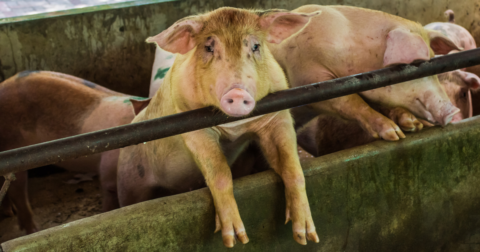Feature
Oklahoma’s Ban on Chinese-Owned Farmland Made an Exception For Smithfield Foods
Food•9 min read
Explainer
Here’s what you need to know about the pork industry in the United States.


Words by Seth Millstein
Pork is the most-consumed meat in the world, and American pork farms play a major role in facilitating this. There are over 66,000 pork farms in the U.S., with an average of 1,089 pigs on each farm, and as much as one-third of that pork is exported around the world. But that comes at a significant cost: pork production is awful for the environment, animals and the humans unfortunate enough to live near pig farms.
The largest pork producer in the U.S. is Smithfield Foods. Though it was founded and is based in the U.S., Smithfield was purchased in 2013 by a Chinese company called the WH Group, which still owns it today.
Based out of Smithfield, Virginia, Smithfield Foods has 55,000 employees — 40,000 in the U.S. and 15,000 in Europe. In the U.S., Smithfield Foods’ operation consists of around 450 company-owned farms and 2,000 contract farms spread across 15 states. The company generated $14.4 billion in revenue in 2023, and slaughters nearly 18 million pigs every year.
All 50 states have pig farms, but they aren’t evenly distributed around the country. Most of the country’s pig farms are in either the Midwest or North Carolina, as the climates and available land in those regions are most amenable to pig farming. Sixty-eight percent of the pig farms owned by Smithfield Foods are located in either Missouri or North Carolina, and the majority of its leased farms are in North Carolina.
The U.S. state that produces the most pork is Iowa, and it’s not even close. Nearly one-third of all pigs in the country·are raised in Iowa, and the state produced 14.3 billion pounds of pork in 2022. With a population of 3.16 million humans and 24.6 million pigs, there are almost eight pigs for every human in Iowa.
In order, the top 10 pork-producing states in the U.S. are:
According to the most recent Census of Agriculture, the 10 U.S. counties with the largest populations of farmed pigs are:
Pork production fluctuates from year to year, but in 2022, the U.S. produced 40.6 billion pounds of pork. Most of this is for domestic consumption; however, the U.S. has increasingly become a major player in the international pork trade as well. In 2022, the U.S. exported 6.3 billion pounds of pork to other countries — primarily China, Japan and Mexico — making it one of the top exporters of pork in the world.
According to the Sentience Institute, over 98 percent of farmed pigs in the U.S. are raised on factory farms — and running a factory farm isn’t cheap. Feed, water, housing, transportation, electricity, additives, vaccines, labor, maintenance and fuel are but a few of the expenses inherent in running a pork farm.
The profitability of a pork farm depends on whether the farmers can sell the body of a slaughtered pig for more than it cost to breed and raise the pig, and due to constant fluctuations in demand and feed prices, pork production profits differ every month. For a number of reasons, 2023 was the least profitable year for hog farms on record, with farmers losing an average of $32 for every hog sold.
In addition to the costs needed to sustain the animals, producers have to consider the exceptionally high mortality rate among modern farmed pigs. According to Iowa State University, one out of three farmed pigs in the U.S. die before slaughter, and each one of these deaths cuts into the farm’s profits.
Pork producers increasingly need to consider legal costs too, as they’ve faced a growing number of lawsuits in recent years by communities that have been negatively impacted by nearby pork operations. In 2020, Smithfield Foods reached an undisclosed settlement with hundreds of residents of North Carolina, who accused the company’s hog farms of creating an unbearable stench that made it impossible to spend time outside. The company decided to settle after losing five earlier cases related to the same issue.
Factory farms are a nightmare for the animals forced to live in them, and hog farms are no exception. Male pigs are castrated without anesthetic and removed from their mothers shortly after birth, while female pigs are kept in crates that are only slightly larger than their bodies, and are forcibly impregnated until they’re no longer able to give birth. Pigs of all genders also have their tails cut off and their ears sliced as part of the pork production process.
Disease outbreaks are common on pig farms as well. A particularly nasty example is African swine fever, a highly contagious disease that causes hemorrhaging, diarrhea and vomiting in the pigs who contract it. In 2018, an African swine fever outbreak in China killed 40 percent of the country’s entire supply of pigs, which amounted to 25 percent of all pigs on the planet.
Thankfully, humans can’t contract African swine fever. But they can contract plenty of other diseases that run rampant on pig farms, such as salmonella, E. coli and trichinosis, all of which humans can get by eating infected pork. According to the Centers for Disease Control, human consumption of pork results in 525,000 illnesses, 2,900 hospitalizations and 82 deaths every year.
Slaughtered pigs in the U.S. are theoretically inspected by the Department of Animal Agriculture (USDA). In 2019, however, the USDA both reduced the number of trained food inspectors in meat plants and eliminated the slaughter line speed limit for pigs, thus allowing plants to slaughter pigs at any speed they choose. The changes were so alarming that several inspectors filed whistleblower disclosure forms with the federal government, arguing that the new policies would result in an increase in food poisoning from contaminated pork.
In addition to their impacts on animal and human populations, pork farms also cause immense damage to the environment. As early as 2006, the UN Food and Agriculture Organization (FAO) identified animal agriculture as “one of the top two or three most significant contributors to the most serious environmental problems.”
Hog farms confine thousands of pigs in small areas, which often results in feces and urine polluting the air and nearby waterways. Pigs excrete an average of 11 pounds of manure every day, and in North Carolina alone, pig farms generate an estimated 15.5 million tons of pig manure every year.
This results in more than just a bad smell. Pig manure contains significant amounts of methane, carbon dioxide and nitrous oxide, all of which contribute to global warming. It’s estimated that pork farms emit 4.87 kilograms of CO2eq, or greenhouse gasses, for every kilogram of pig carcass — and 89 percent of that comes from manure.
The problems don’t stop there. Pork farmers often “dispose” of manure by spraying it into the air over crops, a process known as “muck-spreading.” In addition to being a disgusting concept, muck-spreading also results in manure polluting nearby water sources, contaminating the air, and in some cases, landing on people’s cars and houses.
Multiple studies have shown pigs to be highly intelligent animals who have distinct personalities and enjoy playing and solving problems. Pork farms subject these pigs to non-stop misery, and forbid them from living anything resembling a natural life. The production of pork also wreaks havoc on the environment and endangers the lives of people who live near them.
Instead of perpetuating this exploitative system, we would be wise to look for alternative sources of protein in our diets. Thankfully, there is no shortage of options.